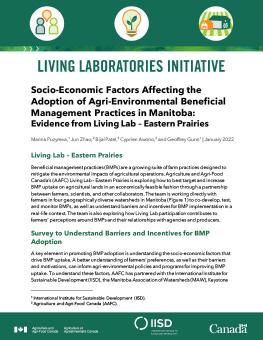
Socio-Economic Factors Affecting the Adoption of Agri-Environmental Beneficial Management Practices in Manitoba
Evidence from Living Lab - Eastern Prairies
This brief summarizes the results of a survey conducted as part of the Living Lab – Eastern Prairies and examines the socio-economic factors that drive the uptake of agri-environmental beneficial management practices in Manitoba, Canada.
-
Age, education, farm size, and financial assistance have significant impacts on producers' adoption of agri-environmental BMPs.
-
The top barriers to BMP adoption are high upfront costs, a lack of financial assistance, and high maintenance costs.
-
Most respondents who have participated in the Living Lab indicated that their participation increased the likelihood of adopting other BMPs in the future.
In 2020, the International Institute for Sustainable Development (IISD) and Agriculture and Agri-Food Canada (AAFC) collaboratively developed a survey to understand socio-economic factors affecting the adoption of agri-environmental beneficial management practices (BMPs) in Manitoba. BMPs are a growing suite of farm practices designed to mitigate the environmental impacts of agricultural operations.
The survey was administered in partnership with the Manitoba Association of Watersheds (MAW), Keystone Agricultural Producers (KAP), and the Manitoba Forage and Grasslands Association (MFGA) in the four Living Lab – Eastern Prairies participating watersheds and other watersheds in Manitoba. Seventy producers responded to the survey. The results provide important insights into BMP adoption decisions and help inform BMP-related policies and programs. These insights include:
- The socio-economic factors affecting BMP adoption
- Producers’ trusted sources of agri-environmental information
- The barriers and incentives to BMP adoption
- The impacts of Living Lab participation on producers’ perceptions around BMPs and their relationships with agencies and other producers.
Participating experts
You might also be interested in
How Can We Work With Nature to Tackle Drought and Desertification?
Drought is one of the most devastating and pervasive challenges exacerbated by climate change. However, we can work to reduce its effects through nature-based solutions for land restoration and climate-smart agriculture.
Modelling the Impacts of Policy Interventions for Agrifood Systems Transformation in Indonesia
This report provides context and insights for agrifood systems transformation efforts in Indonesia by detailing an innovative modelling approach and offering policy implications and next steps to inform the Indonesian government's development planning.
Rethinking Investment Treaties
International investment treaties and their investor–state dispute settlement (ISDS) system are facing growing scrutiny. But what would an alternative system—one fit for the challenges of the 21st century—look like?
INC-4 Is an Opportunity to Address Fresh Water Pollution – This is how
INC-4 is the fourth meeting in a series of international negotiations that aims to develop a global treaty on plastic pollution that could and should have big implications for freshwater quality both in Canada and beyond.